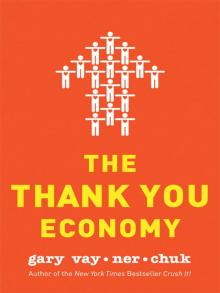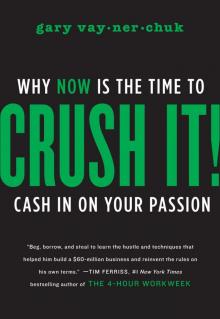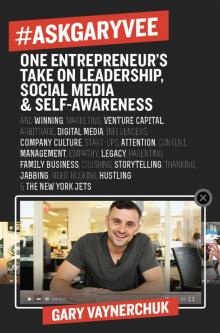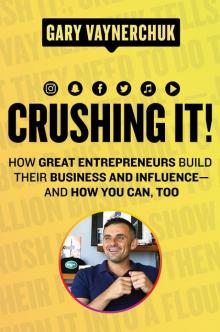- Home
- Gary Vaynerchuk
Jab, Jab, Jab, Right Hook
Jab, Jab, Jab, Right Hook Read online
DEDICATION
TO MY TWO KIDS, MISHA AND XANDER. YOU HAVE BROUGHT A KNOCKOUT PUNCH OF LOVE TO MY LIFE THAT I DIDN’T KNOW EXISTED. AND TO THE WOMAN WHO BROUGHT THEM TO ME, THE LOVE OF MY LIFE, LIZZIE.
CONTENTS
Dedication
Acknowledgments
Author’s Note
Introduction: Weigh-In
Round 1: The Setup
Round 2: The Characteristics of Great Content and Compelling Stories
Round 3: Storytell on Facebook
Round 4: Listen Well on Twitter
Round 5: Glam It Up on Pinterest
Round 6: Create Art on Instagram
Round 7: Get Animated on Tumblr
Round 8: Opportunities in Emerging Networks
Round 9: Effort
Round 10: All Companies Are Media Companies
Round 11: Conclusion
Round 12: Knockout
Notes
About the Author
Also by Gary Vaynerchuk
Credits
Copyright
About the Publisher
ACKNOWLEDGMENTS
I have so many people to thank I could never fit all their names into a tweet, so I decided to put them in an acknowledgments page.
First and foremost, I want to thank my family, whom I love very much and who always help me, support me, and drive me. They really are the guiding light to my life.
I also want to thank Stephanie Land, who is my true partner in writing these books. This is the third book we’ve written together. Steph—thank you so much. I truly, truly could never write a book without you.
Huge shout-out to my boy Nathan Scherotter, who is the CEO of this book. Nate has been an amazing friend and business associate for many years. His help in guiding this book’s content and then its sales afterward was immensely important. I love him like a brother—except when we play basketball against each other.
I’d also like to thank everyone at VaynerMedia who helped with this project. Kelly McCarthy, Marcus Krzastek, and Etan Bednarsh—thank you so much for being such great partners and family. Another big shout-out to the crew of Vikash Shah, Steve Unwin, Sam Taggart, Colin Reilly, Alan Hui-Bon-Hoa, Haley Schattner, India Kieser, Jed Greenwald, Jeff Worrall, Katie Katherine Beattie, Nik Bando, Patrick Clapp, Michael Roma, and Simon Yi for helping with the content of #JJJRH. Also to Andrew Linfoot, George Barton, and Kyle Rosen for interning over the summer and helping with the process.
Another big thank-you to everyone at HarperCollins. Hollis Heimbouch and her team have always been great to work with and a valuable asset every step of the way.
But most of all, I want to thank all the fans and others who have been following for the past four or five years as I’ve discussed the current trends. Obviously, it is a cliché to say I wouldn’t be here without you—but the fact is, I wouldn’t. If you didn’t continue to buy my books, read them, or react to them, I wouldn’t write them. This is for you.
Last, and as always, I have to say thanks to my immediate family, whom I love with all my heart. My parents, Sasha and Tamara, and my grandmother Esther. To my brother A. J. and his wonderful girlfriend, Ali. To my sister Liz, my brother-in-law Justin, and their two kids, Hannah and Max. To my brother-in-law Alex, his wife, Sandy Klein, and their children Zach and Dylan. As well as to my wonderful in-laws, Peter and Anne Klein. All of you mean the world to me.
AUTHOR’S NOTE
At the time of this writing, I hold Facebook stock. I also hold Twitter stock, bought in 2009. I owned Tumblr stock that was sold in the 2013 sale to Yahoo.
I don’t hold any Snapchat or Pinterest stock, but I wish I did.
I have been careful not to critique any competitors of current VaynerMedia clients for the case studies that appear in this book.
INTRODUCTION:
WEIGH-IN
A look at my Twitter feed during football season reveals that pretty much the only thing that can dampen my optimistic outlook and love for life is when the New York Jets do something stupid, like their quarterback running into his offensive lineman’s ass and fumbling the ball, giving the opposing team a touchdown. You know, the usual. It’s no secret that I intend to buy them one day. Maybe not from Woody Johnson, maybe from his successor, but someday. So every loss cuts me to the quick. Yet while my heart belongs to football, that’s not the sport that dominates my thinking most of the time. Most of the time, unless I’m with my family, I’m doing business. Which means that most of the time, like a lot of other businesspeople, marketers, and entrepreneurs, I’m boxing.
Fast-paced, competitive, and aggressive, boxing is a natural metaphor for doing business. And despite its decline in popularity over the last few decades, we have incorporated its lingo into our language probably more than any other sport. I hear it in boardrooms all the time. When managers and marketers outline their social media strategies, they often talk about the “knockout punch” or “right hook”—their next highly anticipated sale or campaign—that’s going to put the competition out for the count. Their eyes gleam the same way a twenty-year-old Mike Tyson’s probably did right before it took him less than six minutes to knock out Trevor Berbick and become the youngest heavyweight champion in boxing history. They’re bloodthirsty. Even at companies where I see impressive efforts to patiently build the relationships so crucial to successful social media campaigns, marketers are itching to land the powerful, bruising swing that will knock out their opponent or their customer’s resistance in one tooth-spritzing, killer blow. Right hooks, after all, convert traffic to sales. Right hooks earn Cannes Cyber Lions Awards. They easily show results and ROI. Except when they don’t.
That’s the truth, isn’t it? We’ve seen a few well-placed social media hits over the years, but more often than not, social media marketers are throwing their best right hooks all over Facebook, Twitter, Instagram, and YouTube, yet still failing to land killer blows in the form of increased sales and market share. They’re swinging as hard as they can, and then . . . whoosh. No connection. And it’s not that the spot didn’t reach any eyeballs. People saw it; they just didn’t care. Despite terrific customer awareness, the brand’s content wasn’t compelling enough to inspire consumers to do anything with it.
I thought it would be three or four years before I wrote another book. I thought I’d said everything I needed to say for now. I’ve been on a mission to convince marketers that today, business is all about making the customer happy. After spending so much time preaching the importance of the jab—the one conversation, one engagement at a time that slowly but authentically builds relationships between brands and customers—the last thing I wanted to do was write a book that outlines how to execute a killer right hook with content. Because I suspect that deep down inside, if given the choice most businesspeople would ditch the whole social engagement thing and just go for the punch, because the social engagement thing is hard and takes too much time. We’re primed for immediate gratification, and if we don’t have to be patient, we won’t. So I’m nervous that if I put out a book offering a blueprint to the perfect content for every major social media platform relevant today, a lot of people are going to think they can now ease up on the time-consuming task of engaging with their customers. Armed with a foolproof, knockout right hook, you don’t need as many jabs to win, right?
Wrong. Wrong, wrong, wrong, wrong, wrong.
There’s a reason why boxing is called “the sweet science.” Critics dismiss the sport as mindlessly barbaric, but where they see violence, those of us who understand and respect it see strategy. In fact, boxing is often compared to chess for the amount of strategic thinking it requires. The right hook gets all the credit for the win, but it’s the ring movement and the se
ries of well-planned jabs that come before it that set you up for success. Without a proper combination of jabs to guide your customer—I mean, your opponent—right where you want him, your right hook could be perfect and your opponent could still dodge it as easily as a piece of dandelion fluff. Precede that perfectly executed right hook with a combination of targeted, strategic jabs, however, and you will rarely miss.
The realization that I had to write this book occurred in late 2012, on a red-eye flight home from the West Coast. I was exhausted, slumped against the side of the plane with my forehead pressed against the window because I was too tired to hold my head up. And I was thinking back to Wine Library TV, the online wine video blog that launched my career in social media marketing and helped pave the way to where I am now.* I’ve always credited the success of that venture to my hustle and single-minded dedication to engaging with my fans and customers by answering every email or blog comment I received and going overboard to show my appreciation for their business. But I had just spent another day analyzing a potential client’s floundering, misguided, and downright lackluster social media campaign. Despite their earnest efforts to engage with their customers, they were seeing little brand awareness or sales momentum. And as I sat there mulling over how to help them, not sure whether I was about to catch my second wind and answer emails, or drop into a coma, I had an epiphany. The content. When I launched Wine Library TV, I chose to do long-form video blogs, about twenty minutes apiece, on a platform (YouTube, and later in 2007, Viddler) where asking people to stick around for five minutes was like asking them to sit through the desert scene in the uncut version of Lawrence of Arabia. And yet they had stuck around, relaxing with their feet up in front of their computers, to watch me taste wine and hear my opinions. Why? Maybe Wine Library TV didn’t catch fire just because I hustled more than everybody else. Maybe its popularity wasn’t just due to my unique combination of expertise, humor, and irreverence (not to mention spellbinding charisma). My high-quality content definitely factored in, but that might not have mattered had I not also made native content—authentic content perfectly crafted for that particular new platform, YouTube, not thanks to good lighting or smart editing, but because it embraced authenticity and “realness.” And maybe I needed to make sure that my clients and others who turned to me for advice were doing the same.
The business world had stubbornly resisted accepting that a short-term approach to social media wasn’t going to work, so I’d spent the majority of my time and effort over the years emphasizing the importance of the long view, and teaching people how to communicate in such a way that would develop authentic and active customer relationships. My last book, The Thank You Economy,* could easily have been titled Jab, Jab, Jab, Jab, Jab! It was told in two parts: One half built a strong argument for the ROI of jabbing your customers—engaging through incredible, heartfelt service and social media—and the other half presented case studies illustrating great jabs and how they increased conversion rates. But while it’s true that you can’t land a solid right hook if you don’t set up the punch with a series of good jabs, it’s also true that no fight has ever been won on jabs alone. Eventually, you have to take your shot. Sitting on that plane, I realized that I had become so intent on perfecting people’s jabs, I had neglected to pay enough attention to improving their right hook.
One reason I talked very little about the actual moment of conversion in The Thank You Economy was that it came out on the heels of my first book, Crush It!,* which explained what great content should look like and introduced a number of platforms that to many seemed bizarre and even pointless at the time but which have now become widely accepted as crucial to business. But that was four years ago. Pinterest and Instagram were still in development. The majority of our Facebook status updates were text, not photographs. No one owned an iPad. Right hooks have to be done differently now, thanks to the massive change and proliferation we’ve seen in social media platforms. I wasn’t sure I wanted to write another book, but I had to, because what I’ve learned in the past year or so is so pressing it needs to be said right now. I think I know what the future of successful marketing looks like. What else is new? As usual, a lot of people will disagree with me. But I think I’m right, and I like that feeling.
Jab, Jab, Jab, Right Hook is an update of everything my team at VaynerMedia and I have learned about successful social media and digital marketing through the work we’ve done with thousands of start-ups, Fortune 500 companies, many celebrities, and a substantial number of entrepreneurs and small businesses since that day on the airplane. A mash-up of the best elements of Crush It! and The Thank You Economy with a modern-day spin, it offers a formula for developing social media marketing strategies and creative that really works. We’ll still discuss engagement, because I still think most people aren’t engaging enough to set up their jabs as well as they should, but this book will emphasize right hooks. Specifically, how to create perfect and distinct native content for every one of the multiple platforms you now have to use to cross-pollinate your brand and message.
No matter who you are or what kind of company or organization you work for, your number-one job is to tell your story to the consumer wherever they are, and preferably at the moment they are deciding to make a purchase. For a long time, we did that through television, radio, and print. We evolved with the times, eventually attempting guerrilla marketing, sending emails, and creating banner ads. But the attention-grabbing power of these older platforms is weakening, their audience is shrinking, and every day that goes by costs us more to reach fewer people, because though those older platforms still serve their purpose, people are just not watching television, listening to radio, reading print, or even paying much attention to emails. At least, not as often as they used to. They’re on social media.
These platforms still feel new and untested. I get that. But enough waiting around. Now that the infrastructure is built and the plumbing is in place, it’s time to learn how to use the system to achieve your business objectives, and to put more time, energy, and dollars into the place where the consumers actually are, and not where you wish they would stay. Social media platforms offer us our best chance to stretch our working dollars the furthest.
Consider this book a training camp to prepare you to storytell on today’s most important social media sites. In order to ensure that the book retains its value over time, all of the platforms selected for analysis have at least three to five years left in them (that’s actually an impressive life span for an Internet platform). You’ll learn how to create the storytelling formula that will most resonate with consumers as they look at their mobile device forty times a day. In addition, we will examine good, bad, and ugly examples of some famous and not-so-famous brands’ social media storytelling. In this way, I hope to deliver on the promise I made myself when I decided to write this book: to create a guide to steer people away from common social media marketing pitfalls, and a reference that people can come back to again and again. As in boxing, once you learn the science of the social media sport, you will be able to apply what you learn in these rings to any platform that crops up in the future. And that’s a great story.
I see this as the final book in a trilogy that covers not only the evolution of social media, but my own evolution as a marketer and businessman as well. (My next book will probably be about parenting. Or maybe root beer. Or even how I bought the Jets.) The world changes, platforms change, and we learn to adapt. But the secret sauce remains the same: The incredible brand awareness and bottom-line profits achievable through social media marketing require hustle, heart, sincerity, constant engagement, long-term commitment, and most of all, artful and strategic storytelling. Don’t ever forget it, no matter what you learn here.*
ROUND 1:
The SETUP
Where’s your phone?
In your back pocket? On the table in front of you? In your hands because you’re using it to read this book? It’s probably somewhere within easy reach, unless yo
u’re one of those people who are constantly misplacing their phones and my question has you rummaging through the laundry basket again or checking under your car seat.
If you’re in a public space, look around. I mean it, pop your head up. What do you see? Phones. Some people are doing the old-fashioned thing and using them to actually talk to another person. But I predict that someone, and probably several someones, within a four-foot radius is playing Dots. Or double-tapping a picture. Or composing a status update. Or sharing a picture. Or tweeting. In fact, unless you’re visiting Aunt Sally in the nursing home—and even then, you’d be surprised at how iPads are crashing the ninety-year-old demo lately—it’s more than likely that almost everyone around you has a smartphone in his or her possession, and if not a phone, then a tablet. I know this because there are nearly 325 million mobile subscriptions in the United States alone.
And when people are using their devices, it’s probable that almost half are networking on social media.
If I wrote that line correctly, it should read with the kind of serious tone we reserve for Very Important News. But what’s the big deal? By now everyone gets it—social media is everywhere. It has changed the way society lives and communicates. It’s no longer just the first adopters and the young who are hooked—71 percent of people in the United States are on Facebook, more than a half billion globally are on Twitter—a population that includes everyone from the pope to a parrot named Rudy, and almost every small business in America in between—and almost half of all social network users check in on these sites at least once a day, often as soon as they wake up in the morning. It has altered the way people fall in and out of relationships, stay in touch with family, and find jobs. Finally, there are few if any holdouts who will deny that today business simply can’t be done without it, especially when one in four people say they use social media sites to inform their purchasing decisions.* Boomers, who control 70 percent of U.S. spending, increased their social usage 42 percent in one year. Moms, the buyers and budget analysts for most families, are all over it. The eyeballs marketers want to reach, the ones belonging to people who make purchasing decisions and who have money to spend, are spending increasing amounts of time on social media sites. They are doing this because they are no longer tied to their laptops and PCs to get their social media fix. Thanks to their smartphones and tablets—and eventually, their glasses and who knows what else—where they go, their social networks go, too.

 The Thank You Economy
The Thank You Economy Crush It!
Crush It! #AskGaryVee
#AskGaryVee Crushing It! EPB
Crushing It! EPB Jab, Jab, Jab, Right Hook
Jab, Jab, Jab, Right Hook